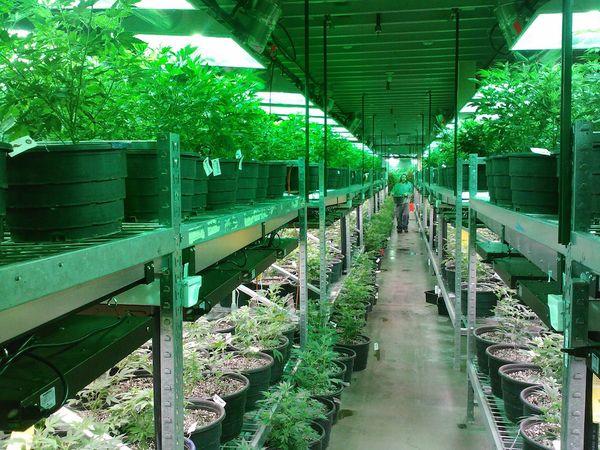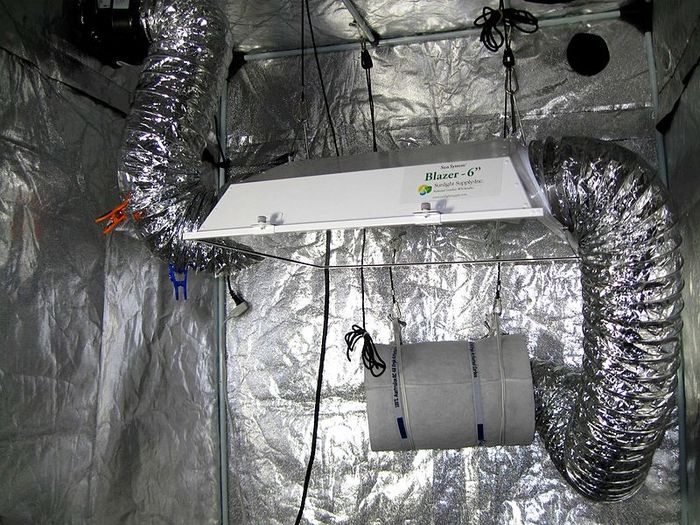- One of cannabis’s most distinct characteristics is its scent. While this can be a source of pleasure for growers, it can also become a problem if they need to conceal the presence of their plants.
- To prevent the smell of weed there are different methods available, for both indoor and outdoor crops, ranging from home remedies, like planting other aromatic species in the area, to installing carbon filters in ventilation systems to clean the air and avert suspicion.
- We explain the different options to you.

How many times have you detected the presence of cannabis by its fragrance? Many times you have surely picked up a familiar scent and then, a few meters further on, came across a cannabis crop. Sometimes, no matter how well concealed your cannabis plants are, their scent can give them away. But don't fret, as there are several methods, both indoors and out, to avoid attracting unwanted attention.
Flowering time is when your cannabis gives off the strongest scent, but some strains are more fragrant than others. Thus, if you prefer not to take your chances in this regard, you can select ones likes California Hash Plant, Industrial Plant or Blue Thai, which feature citrus touches that partly mask their scent. Keep in mind, though, that all cannabis plants emit aromas, so it is important to be prepared to neutralise them.
Methods to remove odours from indoor crops
If you have a large indoor crop with which home remedies do not seem to be solving your problem, it is best to use an odour control system that guarantees their total elimination.
Active carbon filters
These are those most often used by beginner growers who do not want to arouse any suspicions. Some even claim that these filters are essential for indoor crops because they prevent the aroma from plants from escaping through the ventilation system.
However, if you opt for this solution you must not forget that to function properly they need to be connected to a tubular air extractor adapted to their capacity.
In this way, the smell coming from growing cabinets and growing rooms passes through the filter, which is full of small pellets of active carbon that neutralise the scent in the air. Unlike the case with other products that we will indicate below, filters do not emit any other kind of aroma. Rather, they produce air devoid of cannabis traces. These products are available in various diameters and capacities, depending on the needs of one's crop. On the market you can also find other types of more modern, latest-gen filters, such as those offered by Can Filters, CarbonActive and Odorsok. The first is from the largest manufacturer of activated carbon filters in Europe, and they last around 30 months.
Choosing the filter that best suits your needs will depend mainly on the size of your crop. The bigger it is, the more powerful the filter must be, so that it can purify all the air.
One way to know exactly which is the right one for you is to know how many cubic meters of air there are in your crop's growing space. To calculate this, use a simple formula featuring the dimensions of the space it occupies: width x depth x height.
For example, if your growing cabinet measures 10 meters wide, 10 meters deep and 2.5 meters high, calculate 10 x 10 x 2.5, which means it is 250 cubic meters. When choosing your filter it is important that it have a capacity greater than the space calculated. Thus, if your volume is 250 cubic meters, you will need to buy a filter for 300 cubic meters. This will ensure that the filtering is much more effective.
There also exist other filters not containing active carbon inside, such as coconut fibre (coir), which can also be a good choice. In any case, it is important when acquiring a device like this to be sure to get a new one, as filters become less effective with use. In addition, with these filters it is advisable to use a high-quality extractor (such as that seen below) that makes it possible to evacuate purified air without any problems.

Ozone generator, or ozoniser
These devices eliminate odours through the creation of ozone, responsible for destroying odorous particles. There are several models on the market, ranging from 20 to 200 euros, depending on their size.
In addition, ozone generators can be of two types: those that distribute ozone, acting indoors, and those that, adhered to the air extraction tube, purify it before it is released. In the first case you will need to choose one that generates an amount sufficient to cover your growing area. There are different generators that can act in dimensions ranging from 1 square meter up to 100. With such devices you must exercise great caution, as breathing in large amounts of ozone can be bad for your health.

Some growers combine the use of these ozone generators with carbon filters to remove the oxide smell the ozone gives off, thus ensuring a more successful elimination of all types of aromas.
Artificial gels and fresheners
The market offers several products specifically to mask the smell of cannabis. This is the case with the gels and sprays sold by the Canadian brand Ona, which are placed in the area where one wants to neutralise odours. Using both sprays and gels is very simple: the former are sprayed into the air, while the latter come in little bottles, which must be left open to work. These vessels will no longer be effective when the gel inside them dries out.
Other options are dispensers filled with anti-odour cartridges, or air fresheners using essential oils. These also camouflage the smell of cannabis with other, more powerful aromas.

Other ways to fight smells indoors
Having your crop indoors, in an enclosed space, can mean more than one aroma problem. Sometimes this hitch can be solved with some good ventilation. However, if you do not want to risk the neighbours detecting certain scents, you can buy products at specialty stores, or make them yourself.
Some growers choose homemade solutions that do not require any artificial products, as these remedies are simple and will not harm your plants. Some of those most commonly used are:
A glass of vinegar
If you have your crop in a closet, placing a glass of vinegar inside is a good way to combat the plants' smell. The aroma it gives off is so strong that it ends up camouflaging that of the cannabis. Of course, you will need to change it, every three days, after which it is no longer effective.

Lemon and cloves
The use of these products also absorbs odours. To do this you must cut a lemon in two halves and place three cloves in each. These should also be changed every three days so that the lemon does not dry out, and the cloves continue to fulfil their function.

Scented candles and incense
Anything that emits scents can help camouflage the smell of your cannabis. So, using scented candles and incense sticks is a good solution. Just keep in mind is that these remedies do not actually absorb the aroma. They just mask it.

Vanilla essence
You can even make yourself a natural air freshener with vanilla perfume: mix 15 millilitres of vanilla and a tablespoon of oil, and heat it in the oven at 150 degrees. After about 10 minutes you'll start to notice a pleasant fragrance. Let it permeate the whole house to get the smell of the grass to disappear. Your neighbours will think you're baking some delicious dessert.

What about with outdoor crops? How does one deal with aromas?
The methods used indoors are useless on outdoor crops, which are subject to the capricious effects of shifting winds. If you think that when planting outdoors you could run into problems because of aromas, the first thing we recommend is to choose strains with weaker scents, such as those mentioned above.
Outdoors, one has all the advantages and disadvantages of nature. For example, sometimes the wind can be your best friend, blowing away scents you don´t want to be detected. Other times, however, it can be your worst enemy, transporting the scent to your neighbour's house, or a public road that passes near your garden. The best way to prevent this is to plant other plants around it that give off a strong fragrance, using aromatic varieties like thyme, peppermint, mint, and even lavender, which will help mask your cannabis. Use a variety of these plants to distract potentially prying eyes.

The existence of other plants near your cannabis crop will also serve to keep it safe from insects and unwanted pests, because they will attract large numbers of predatory species, such as ladybugs, whose diets include pollen and honeydew. The more biodiversity, the more beneficial they will be for your cannabis plants.



Comments from our readers
There are no comments yet. Would you like to be the first?
Leave a comment!Did you like this post?
Your opinion about our seeds is very important to us and can help other users a lot (your email address won't be made public).